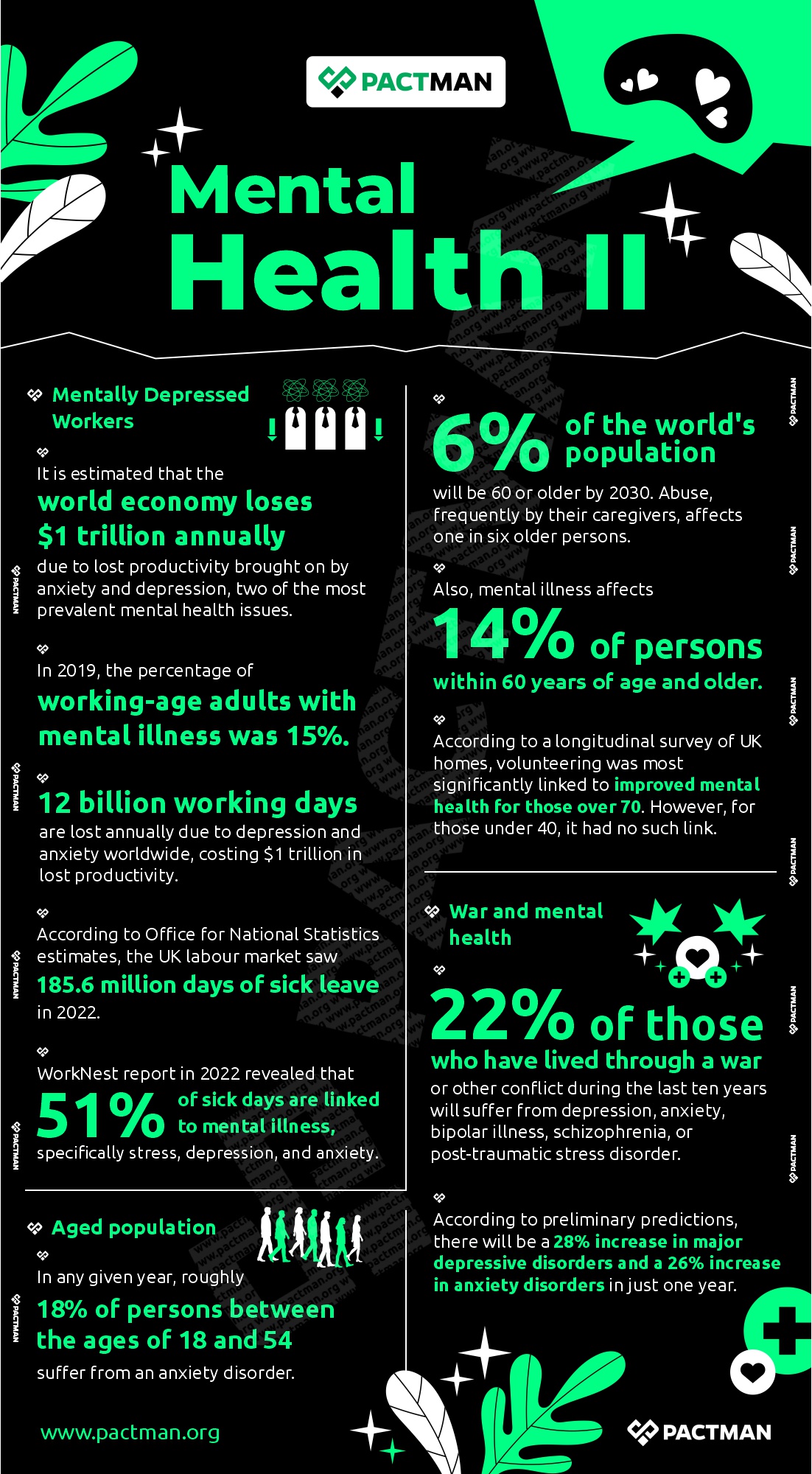I
Introduction
Estimating the financial burden of mental illness can be useful to a large extent. It helps us to understand the importance of addressing mental health issues as a problem deserving of attention and funding.

Over the years, mental health charities have played a key role in the communities they serve by providing direct health and social care services, as well as assisting individuals with day-to-day challenges. These organisations are known to offer professional treatment, undertake research, spread awareness, assist patients, and encourage mental health and well-being.
This article will consider why addressing mental illness is a crucial necessity and the outstanding organisations at the forefront of tackling the global menace.
II
What is mental health?
Mental health is a vital aspect of health and well-being. It supports our capacity as individuals and as a society to make choices, form bonds with one another, and influence the world we live in. Also, it describes the ability to effectively manage life’s stress, attain full potential, learn and work effectively, and give back to the community.
Essentially, mental wellness considers our emotional, psychological, and social well-being. It influences our feelings, thoughts, and behaviours. Likewise, it influences how we respond to stress, interact with people, and make wise decisions.

By and large, mental health is considered a fundamental human right. Furthermore, it is essential for socioeconomic, communal, and personal growth. The World Health Organisation defines mental health as “a state of well-being in which an individual realizes his or her abilities, can cope with the normal stresses of life, can work productively, and can contribute to his or her community.”
Mental illness, which includes behavioural and mental wellness problems like depression and anxiety disorders is the world’s leading cause of ill health in adolescents and young people. Over a billion young people are significantly impacted by mental disorders. Consequently, this has impeded their development, as well as their social and economic integration and employability. In addition, the costs of mental illness remain substantial with its negative impact on businesses, the government, and society at large.
Some schools of thought have asserted the need to measure the economic cost of mental illness. It however is impossible to properly assess the scope of the issue. Not to mention, a dollar sign is undoubtedly an imperfect proxy for some of the repercussions. However, it enables us to see the importance of mental illness as a problem that requires investment, attention, and policy reforms.
III
Critical Statistics on Mental Health
In this section, we will consider the critical impact of mental health illness globally.
1. Depressive illnesses
In 2019, 970 million individuals worldwide, or 1 in every 8 persons, suffered from a mental illness, with anxiety and depressive disorders being the most prevalent. Each year, the three depressive illnesses that affect 9.5% of adult Americans over the age of 18 are bipolar disorder, major depression, or dysthymia.
Suicide ranks as the third most common cause of death among young ones between the ages of 15 to 29. Each year, suicide claims the lives of about 720,000 people. Also, Caucasian men over 85 years old had the highest suicide rates in the United States. 13% of the global burden of disease is caused by mental disorders and it affects one in seven people aged 10 to 19 worldwide. Across the world, low- and middle-income nations account for 73% of suicides. Also, 40 million people worldwide are said to suffer from bipolar disorder.

2. Schizophrenia
In America, schizophrenia affects about 1% of people. Merely 31.3% of individuals suffering from psychosis obtain specialised mental health treatment. Men with schizophrenia typically experience their initial symptoms in their late teens or early 20s. In contrast, the onset of schizophrenia in women often occurs in their 20s or early 30s. In any given year, roughly 18% of persons between the ages of 18 and 54 suffer from an anxiety disorder. Schizophrenia is diagnosed in about 50% of patients in mental health facilities.
3. Mentally depressed workers
There is ample evidence to support the negative impacts of mental illness on economic activity and production. For instance, it is estimated that the world economy loses $1 trillion annually due to lost productivity brought on by anxiety and depression. This comprises two of the most prevalent mental health issues.
In 2019, the estimated percentage of working-age adults with mental illness was 15%. Also, an estimated 12 billion working days are lost annually due to depression and anxiety worldwide. Furthermore, presenteeism and absenteeism account for a significant portion of wasted productive time due to mental health reasons.
The UK labour market saw 185.6 million days of sick leave in 2022, according to estimates from the Office for National Statistics. This led to 159.8 million sick leave days in England in 2022 and adds up to 5.7 days on average for each employee. According to research (2022), 51% of sick days are linked to mental illness, specifically stress, depression, and anxiety.

4. War and mental health
22% of those who have lived through a war or other conflict during the last ten years will suffer from depression, anxiety, bipolar illness, schizophrenia, or post-traumatic stress disorder. According to preliminary predictions, there is a 28% increase in major depressive disorders and a 26% increase in anxiety disorders in just one year.
5. Aged Population
The COVID-19 pandemic of 2020 caused a dramatic increase in the number of persons suffering from anxiety and depressive illnesses. 6% of the world’s population will be 60 years of age or older by 2030. Abuse, frequently by their caregivers, affects one in six older persons. Also, mental illness affects 14% of persons within 60 years of age and older.
The association between volunteering and mental well-being grew as respondents aged. According to a longitudinal survey of UK homes, volunteering was most significantly linked to improved mental health for those over 70. However, for those under 40, it had no such link.
IV
The Negative Impact of Mental Ill Health
The effects of mental illness on people, social networks, the government, corporations, and society as a whole are catastrophic. Numerous emotional, psychological, and social challenges might arise from an individual’s battle with their mental health. These in turn have the potential to impair their general wellbeing. Also, people who are mentally ill frequently report having a reduced quality of life. Their everyday lives are characterised by ongoing emotional distress and diminished functionality.

The Quality-Adjusted Life Year (QALY) scores, which assess longevity and quality of life, are commonly used to quantify the detrimental effects of mental illness on an individual’s well-being. These scores offer a monetary depiction of the degree to which mental illness detracts from one’s welfare. The goal is to facilitate our understanding of the importance of mental illness as a problem deserving of investment, reform, and governmental attention.
Likewise, these approximations examine many cost categories that may be connected. Among such includes early intervention, community services, and prevention measures which may lower the costs associated with human and financial resources.
Impact on work
Also, unemployment is closely linked to the cause of mental illness issues. Poor mental health frequently causes early job loss. In England, issues related to mental health disorders consititute the main reason for work absence. Likewise, the longer a person is unemployed, the more difficult it is to get a job.
People with mental illness issues and their families bear a disproportionate amount of the costs associated with mental illness. In addition, companies incur £101 billion in costs annually, compared to £25 billion by the government. Interestingly, the research indicates that the majority of the expenses associated with mental illness are reflected in lost productivity and declines in well-being rather than in expenditures to health care systems.
Also, a wide range of developmental outcomes are significantly impacted by mental health disorders, which limits prospects for social integration. The formation of secure and healthy connections with classmates, parents, teachers, and romantic partners can impact mental issues during adolescence and early adulthood.
Adolescence is the developmental stage that is essential for forming an identity and assuming roles, particularly among peers. Several mental illness issues have a detrimental impact on a young person’s capacity to build wholesome, supportive relationships and effectively handle disagreements in such interactions.
V
How Can Nonprofits Address Mental Health Issues
In this section, we will consider effective methods that nonprofits can adopt to address mental health disorders across the globe.

1. Combat stigma associated with mental health
Firstly, efforts must be made to combat the stigma associated with mental illness issues among young people and adults. The perceived stigma attached to getting treatment and telling people in authority about one’s symptoms can be decreased with more knowledge and understanding of the ailment. Another crucial step is to increase social marketing campaigns and national programmatic initiatives to boost social awareness of mental issues among young people.
2. Consider cultural and contextual factors
Secondly, cultural and contextual factors must be taken into account while addressing the mental health needs of people worldwide. Individuals’ emotional experiences and their interpersonal interactions are quite different across cultures. Likewise, the way that culture shapes mental health varies thereby resulting in different outcomes of mental health disorders.
Cultural variations impact mental health disorder risk and resilience factors, which in turn affect cross-cultural prevalence and incidence rates. Thus, the choice and modification of suitable preventive and intervention techniques must take culture into account.
3. Establish clear policies and programs
Policies and programs can enhance people’s access to a wide range of services. This can include services that address learning difficulties, which frequently coexist with mental health issues.
However, the majority of low- and middle-income nations lack mental health policies, and less than one-third have a designated youth mental health body. Consequently, this can impact resource allocation, accountability, and the coordination and delivery of services. Policies should mandate that educational institutions carry out preventive programming. Such can include instruction in social-emotional learning and positive behaviour support. Also, there is a need to encourage the integration of mental health services and prevention programs over the entire spectrum.
4. Improve program monitoring and evaluation
In addition to governmental services, charities help to disseminate information about health hazards and the value of screening for illnesses.
Public health campaigns are sometimes spearheaded by the government. However, charities that focus on certain ailments can also play a crucial role in disseminating expert information. This includes increasing public awareness of the risk factors connected to particular conditions.
When charities interact with those impacted by a disease, they ensure that patients are aware of the best ways to treat their condition and what questions to ask their doctors. According to research by the National Osteoporosis Society, patients who receive this kind of education may ask doctors to evaluate their risk of fracture, which will enhance patient care and treatment results. This will help determine which protective and risk factors should be the focus of preventive measures.
Also, data on a wide range of risk and protective factors, as well as outcomes related to mental health, must be gathered regularly. Although several nations have launched surveillance programs, few of these efforts have been long-lasting or sufficiently comprehensive to influence practice.
5. Prioritise research
In low- and middle-income nations, there is a need to document the effects of promising programs. While many policies and programs are helpful, the majority of studies have been carried out in high-income nations. The degree to which these findings apply to different contexts is therefore unknown.
Now more than ever, mental health charities across developing nations must engage in research to determine suitable policies and programs that can address the unique needs of people suffering from mental illnesses.
VI
Top Mental Health Charities Across the Globe
In this section, we will consider the top charities at the forefront of addressing mental health issues and their contribution to society.

a. United for Global Mental Health
The vision of United for Global Mental Health is to create a society where everyone can live a healthy mental life. Hence, the nonprofit is making significant progress in increasing assistance, decreasing stigma, and increasing awareness about mental health globally.
To achieve its aim, the nonprofit also collaborates with reliable partners who share its vision for a better society. Also, through reliable partners, United for Global Mental Health seeks to eradicate global stigma and increase support. To further this goal and emphasis, the nonprofit employs its knowledge in advocacy and policy.
United for Global Mental Health works to identify and address the mental health needs of those who are frequently marginalised in their society. This is by establishing and advancing forums for communities to speak for themselves.
b. Mental Health Initiative
Mental Health Initiative is a 501(c)(3) nonprofit organisation that works to ensure everyone suffering serious and persistent mental issues can obtain efficient treatment irrespective of financial situation or insurance coverage.
MHI further promotes systemic improvements that advance education and expand access to efficacious treatment options. By and large, the nonprofit is dedicated to discovering and eliminating treatment-related hurdles. MHI understands that these impediments are complex and go beyond money. By tackling these issues, the nonprofit works to realise its societal goal in which mental health services are available to everyone and no one is left behind owing to a lack of resources or awareness.
c. Off the Record (OTR)
OTR is an organisation that prioritises social movement on mental health by and for young people. As signs of mental health disorders typically appear before the age of 15, early detection and treatment can have a significant impact.
The nonprofit provides information and assistance on mental illness to young people aged 11 to 25. Also, OTR offers free, private, self-referral treatments to address mental and emotional health issues. This includes substance misuse, eating disorders, family dissolution, depression, anxiety, OCD, abuse, and self-harm. The nonprofit stands out for its comprehensive awareness of users’ needs and its capacity to interact with difficult-to-reach groups.
d. Restore
Restore is the sole nonprofit organisation committed to assisting those struggling with mental ailments concerns in Oxfordshire, UK. Restore also helps these individuals in finding paid or volunteer work. This is because 80% of them have severe and persistent mental issues, which makes it difficult for them to find and retain employment.
Essentially, the nonprofit services entail assisting clients in creating personal objectives, putting plans in place to attain them and establishing one-on-one coaching and rehabilitation groups. In addition, the charity fights stigma around mental health problems, offers guidance on disability rights at work, and is a leading force for the enhancement of mental health services in Oxfordshire.
Conclusion
These award-winning organisations attest to the significant contribution that community-based projects make to the health and social care system. The nonprofits were evaluated based on six criteria, including innovation, achievement, and attention to community needs. By and large, these organisations provide excellent examples of the benefits of community-based strategies that emphasise mental illness prevention and efficient condition management.



3 Responses